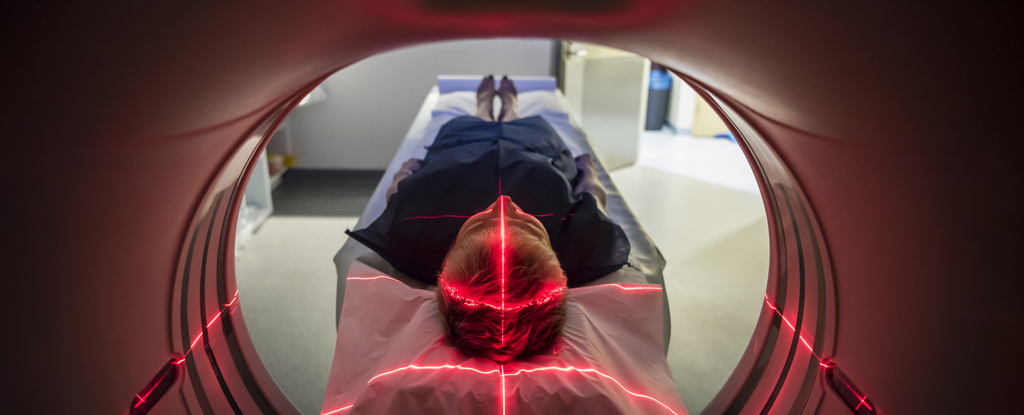For a not insubstantial fee, many private clinics in the UK offer full-body MRI scans to detect disease and abnormalities at the earliest stage. Kim Kardashian and Kate Hudson are fans. (Other celebrity endorsements are available.)
So how do these scans work and are they “life saving”, as Kardashian suggests?
MRI produces 3D detailed anatomical images of almost every internal structure in the human body, including the organs, bones, muscles and blood vessels. MRI scanners create images of the body using a large magnet and radio waves.
Unlike X-rays or CT, it doesn’t rely on ionizing radiation, which can very slightly increase the risk of cancer.
Prices of full body scans in the UK range from £1,000 to £3,000. While they give a good basic overview of your anatomy, they don’t optimize the view of each organ or system.
Any unusual findings would need to be further investigated by specialized MRI scans for things such as the heart and prostate. This is because the machine needs to be adjusted to different parameters to optimize the imaging of different organs and systems.
It’s important to note that MRI scans cannot detect most preventable diseases. Heart disease, high blood pressure, high cholesterol and diabetes are responsible for most deaths.
MRI scans cannot detect these conditions. They may show some structural changes, but other symptoms will probably have emerged first.
Full-body MRI scans may find abnormalities, often referred to as “incidentalomas” because they are just incidental findings, on scans being undertaken for other symptoms.
Studies looking at over 16,000 brain MRI scans of volunteers have shown that less than 4 percent of them contained abnormalities that required further investigation.
The kind of things found on brain scans include pituitary abnormalities, such as non-cancerous growths. Disrupted blood flow to the brain (without symptoms) has been detected in 7 percent, aneurysms in 1.8 percent and benign tumors in 1.6 percent of the population.
Small clusters of abnormal blood vessels, known as cavernomas, rarely cause symptoms and are seen in about one in 600 people on MRI scans. Those that do cause symptoms are seen in about one in 400,000 people.
Another area of the body that often throws up incidental findings is the spine. There is increasing use of MRI in back pain. This can lead to the discovery of incidentalomas such as harmless bone growths and hemangiomas, small growths of blood vessels on or in the spine.
Hemangiomas are seen in over 40 percent of people who receive MRI scans, 99 percent of which cause no symptoms and don’t need treatment. The 1 percent who have symptoms, such as pain, numbness or weakness, require surgery to prevent progression towards paralysis.
Tarlov cysts, an outpouching around nerves leaving the spinal cord in the sacral region (near the bottom of the spine) are seen in about 4 percent of the population. For most, there are no symptoms.
But those who have symptoms, such as pain and numbness, may need surgery to prevent bone decay or damage to the nerve supply to the legs, pelvic structures and genitals.
What about serious findings?
A meta-analysis (a study that combines data from many studies) suggests that serious problems that are picked up by chance on MRI scans are 1.4 percent for the brain, 1.3 percent for the chest and 1.9 percent for the abdomen.
There is also a risk that these scans give a false positive – things that look like disease but aren’t. Breasts (up to 97 false positives per 1,000 scans) and prostate (29 per 100 scans) are particularly susceptible to false positive results.
These scans may give some valuable information about what is going on beneath your skin. However, for many people, the reports and terminology used in them are hard to fathom.
There is lots of evidence that the average person struggles to understand common medical phrases and often assign meaning opposite to what the doctor intended – for a single diagnosis. Reports resulting from these scans are about the whole body and will contain significantly higher levels of medical information than a single diagnosis – even when everything is normal.
Where people pay for these scans without the wherewithal to cover any follow-up medical investigation, it will be already overstretched healthcare systems that have to pick up the fallout and ensure that false positives and benign growths are confirmed as such.
These scans offer an opportunity to see what’s going on internally – for those with enough money to afford them – but the likelihood of finding something that needs urgent medical treatment is low. If I had the money to spend on one of these, I’d spend it on a holiday, which would be far better for my health.
Adam Taylor, Professor and Director of the Clinical Anatomy Learning Centre, Lancaster University
This article is republished from The Conversation under a Creative Commons license. Read the original article.





